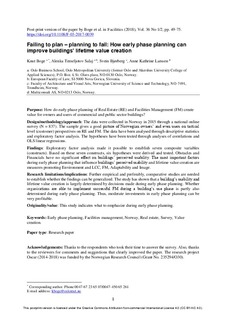| dc.contributor.author | Boge, Knut | |
| dc.contributor.author | Temeljotov Salaj, Alenka | |
| dc.contributor.author | Bjørberg, Svein | |
| dc.contributor.author | Larssen, Anne Kathrine | |
| dc.date.accessioned | 2019-05-13T09:30:50Z | |
| dc.date.available | 2019-05-13T09:30:50Z | |
| dc.date.created | 2018-04-24T16:04:51Z | |
| dc.date.issued | 2018 | |
| dc.identifier.citation | Facilities. 2018, 36 (1/2), 49-75. | nb_NO |
| dc.identifier.issn | 0263-2772 | |
| dc.identifier.uri | http://hdl.handle.net/11250/2597379 | |
| dc.description.abstract | Purpose
The purpose of this paper is to know how do early-phase planning of real estate (RE) and facilities management (FM) create value for owners and users of commercial and public sector buildings.
Design/methodology/approach
The data were collected in Norway in 2015 through a national online survey (N = 837). The sample gives a good picture of Norwegian owners’ and even users on tactical-level (customer) perspectives on RE and FM. The data have been analysed through descriptive statistics and exploratory factor analysis. The hypotheses have been tested through analyses of correlations and ordinary least square (OLS) linear regressions.
Findings
Exploratory factor analysis made it possible to establish seven composite variables (constructs). Based on these seven constructs, six hypotheses were derived and tested. Obstacles and financials have no significant effect on buildings’ perceived usability. The most important factors during early-phase planning that influence buildings’ perceived usability and lifetime value creation are measures promoting environment and life-cycle costs (LCC), FM, adaptability and image.
Research limitations/implications
Further empirical and preferably, comparative studies are needed to establish whether the findings can be generalized. The study has shown that a building’s usability and lifetime value creation is largely determined by decisions made during early phase planning.
Practical implications
Well-founded early-phase planning of RE and FM may actually provide very high return on the investments and significantly improve the buildings’ lifetime value creation for owners and users. Early-phase planning is also of great importance both for buildings’ physical design, as well as for successful FM during the buildings’ use phase, and may prevent irreversible blunders.
Originality/value
This is a large N empirical study in Norway. The findings indicate what owner and users of buildings should emphasize during early phase planning. | nb_NO |
| dc.language.iso | eng | nb_NO |
| dc.publisher | Emerald | nb_NO |
| dc.rights | Navngivelse-Ikkekommersiell 4.0 Internasjonal | |
| dc.rights.uri | http://creativecommons.org/licenses/by-nc/4.0/deed.no | |
| dc.title | Failing to plan - planning to fail: how early phase planning can improve buildingsʼ lifetime value creation | nb_NO |
| dc.type | Journal article | nb_NO |
| dc.type | Peer reviewed | nb_NO |
| dc.description.version | acceptedVersion | nb_NO |
| dc.source.pagenumber | 49-75 | nb_NO |
| dc.source.volume | 36 | nb_NO |
| dc.source.journal | Facilities | nb_NO |
| dc.source.issue | 1/2 | nb_NO |
| dc.identifier.doi | 10.1108/F-03-2017-0039 | |
| dc.identifier.cristin | 1581354 | |
| dc.description.localcode | This post-print-version is licenced under the Creative Commons Attribution Non-commercial International Licence 4.0 (CC BY-NC 4.0). This is the authors' accepted and refereed manuscript to the article. The final authenticated version is available online at: https://doi.org/10.1108/F-03-2017-0039 | nb_NO |
| cristin.unitcode | 194,61,50,0 | |
| cristin.unitname | Institutt for arkitektur og planlegging | |
| cristin.ispublished | true | |
| cristin.fulltext | original | |
| cristin.fulltext | postprint | |
| cristin.qualitycode | 2 | |

